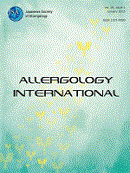70 巻, 1 号
選択された号の論文の29件中1~29を表示しています
- |<
- <
- 1
- >
- >|
Editorial
-
2021 年 70 巻 1 号 p. 1-2
発行日: 2021年
公開日: 2021/01/09
PDF形式でダウンロード (211K)
Invited Review Articles
Review Series: New Insights into the World of Eosinophils in Allergic Diseases
-
2021 年 70 巻 1 号 p. 3-8
発行日: 2021年
公開日: 2021/01/09
PDF形式でダウンロード (1318K) -
2021 年 70 巻 1 号 p. 9-18
発行日: 2021年
公開日: 2021/01/09
PDF形式でダウンロード (1687K) -
2021 年 70 巻 1 号 p. 19-29
発行日: 2021年
公開日: 2021/01/09
PDF形式でダウンロード (5316K) -
2021 年 70 巻 1 号 p. 30-38
発行日: 2021年
公開日: 2021/01/09
PDF形式でダウンロード (779K)
Review Articles
-
2021 年 70 巻 1 号 p. 39-44
発行日: 2021年
公開日: 2021/01/09
PDF形式でダウンロード (1710K) -
2021 年 70 巻 1 号 p. 45-54
発行日: 2021年
公開日: 2021/01/09
PDF形式でダウンロード (1642K)
Original Articles
-
2021 年 70 巻 1 号 p. 55-60
発行日: 2021年
公開日: 2021/01/09
PDF形式でダウンロード (472K) -
2021 年 70 巻 1 号 p. 61-67
発行日: 2021年
公開日: 2021/01/09
PDF形式でダウンロード (844K) -
2021 年 70 巻 1 号 p. 68-73
発行日: 2021年
公開日: 2021/01/09
PDF形式でダウンロード (668K) -
2021 年 70 巻 1 号 p. 74-80
発行日: 2021年
公開日: 2021/01/09
PDF形式でダウンロード (654K) -
2021 年 70 巻 1 号 p. 81-88
発行日: 2021年
公開日: 2021/01/09
PDF形式でダウンロード (863K) -
2021 年 70 巻 1 号 p. 89-95
発行日: 2021年
公開日: 2021/01/09
PDF形式でダウンロード (378K) -
2021 年 70 巻 1 号 p. 96-104
発行日: 2021年
公開日: 2021/01/09
PDF形式でダウンロード (1672K) -
2021 年 70 巻 1 号 p. 105-113
発行日: 2021年
公開日: 2021/01/09
PDF形式でダウンロード (2914K) -
2021 年 70 巻 1 号 p. 114-120
発行日: 2021年
公開日: 2021/01/09
PDF形式でダウンロード (640K) -
2021 年 70 巻 1 号 p. 121-128
発行日: 2021年
公開日: 2021/01/09
PDF形式でダウンロード (2876K)
Letters to the Editor
-
2021 年 70 巻 1 号 p. 129-130
発行日: 2021年
公開日: 2021/01/09
PDF形式でダウンロード (499K) -
2021 年 70 巻 1 号 p. 131-133
発行日: 2021年
公開日: 2021/01/09
PDF形式でダウンロード (989K) -
2021 年 70 巻 1 号 p. 134-135
発行日: 2021年
公開日: 2021/01/09
PDF形式でダウンロード (346K) -
2021 年 70 巻 1 号 p. 136-139
発行日: 2021年
公開日: 2021/01/09
PDF形式でダウンロード (1294K) -
2021 年 70 巻 1 号 p. 140-142
発行日: 2021年
公開日: 2021/01/09
PDF形式でダウンロード (818K) -
2021 年 70 巻 1 号 p. 143-144
発行日: 2021年
公開日: 2021/01/09
PDF形式でダウンロード (296K) -
2021 年 70 巻 1 号 p. 145-147
発行日: 2021年
公開日: 2021/01/09
PDF形式でダウンロード (587K) -
2021 年 70 巻 1 号 p. 148-149
発行日: 2021年
公開日: 2021/01/09
PDF形式でダウンロード (240K) -
2021 年 70 巻 1 号 p. 150-152
発行日: 2021年
公開日: 2021/01/09
PDF形式でダウンロード (721K) -
2021 年 70 巻 1 号 p. 153-155
発行日: 2021年
公開日: 2021/01/09
PDF形式でダウンロード (425K) -
2021 年 70 巻 1 号 p. 156-158
発行日: 2021年
公開日: 2021/01/09
PDF形式でダウンロード (1590K) -
2021 年 70 巻 1 号 p. 159-160
発行日: 2021年
公開日: 2021/01/09
PDF形式でダウンロード (414K)
- |<
- <
- 1
- >
- >|
